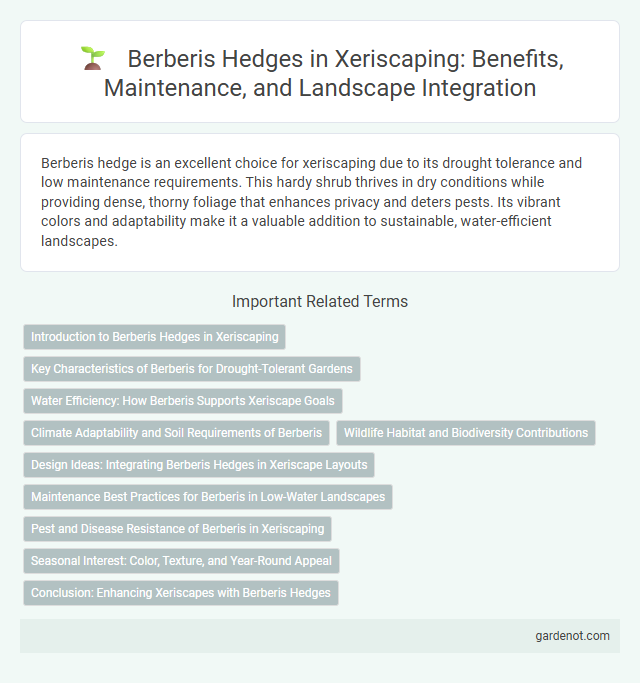Berberis hedge is an excellent choice for xeriscaping due to its drought tolerance and low maintenance requirements. This hardy shrub thrives in dry conditions while providing dense, thorny foliage that enhances privacy and deters pests. Its vibrant colors and adaptability make it a valuable addition to sustainable, water-efficient landscapes.
Introduction to Berberis Hedges in Xeriscaping
Berberis hedges are popular in xeriscaping due to their drought tolerance and low maintenance requirements. These shrubs offer evergreen foliage and vibrant berries, enhancing landscape aesthetics while conserving water. Their dense growth habit provides excellent privacy screening and erosion control in arid garden designs.
Key Characteristics of Berberis for Drought-Tolerant Gardens
Berberis hedges thrive in drought-tolerant gardens due to their deep root systems, which efficiently access underground moisture and reduce water needs. Their small, waxy leaves minimize water loss through transpiration, enhancing survival in arid climates. Vibrant fall foliage and dense growth patterns also provide aesthetic appeal and effective natural screening in xeriscape landscapes.
Water Efficiency: How Berberis Supports Xeriscape Goals
Berberis hedge exhibits exceptional water efficiency due to its deep root system that maximizes water absorption while minimizing surface evaporation, making it ideal for xeriscape landscapes. Its drought-tolerant nature reduces irrigation needs significantly, supporting sustainable water management in arid regions. The plant's adaptability to varying soil types enhances xeriscape goals by maintaining vibrant greenery with minimal water input.
Climate Adaptability and Soil Requirements of Berberis
Berberis hedge thrives in a wide range of climates, exhibiting exceptional drought tolerance and adaptability to both temperate and arid regions, making it ideal for xeriscape landscaping. It performs best in well-drained soils but can tolerate various soil types, including sandy, loamy, and clay soils, provided the drainage is adequate. Moderate soil fertility supports optimal growth while minimizing water needs, aligning with sustainable xeriscape principles.
Wildlife Habitat and Biodiversity Contributions
Berberis hedge provides an essential wildlife habitat by offering dense cover and nesting sites for small birds and beneficial insects. Its berries serve as a vital food source for various bird species, supporting local biodiversity within xeriscape landscapes. The plant's adaptability to dry conditions enhances ecosystem resilience while promoting habitat diversity in water-efficient gardens.
Design Ideas: Integrating Berberis Hedges in Xeriscape Layouts
Berberis hedges offer vibrant color and textured foliage, making them ideal for xeriscape designs that emphasize drought-tolerant landscaping. Their dense, thorny branches serve as natural barriers and visual focal points in layered planting schemes alongside succulents, native grasses, and permeable ground covers. Positioning Berberis along pathways or property lines enhances structure while requiring minimal irrigation, aligning with sustainable water-conserving garden principles.
Maintenance Best Practices for Berberis in Low-Water Landscapes
Berberis hedge thrives in low-water landscapes when maintained with minimal irrigation, promoting drought tolerance and deep root growth. Pruning should be performed in early spring to shape the hedge and remove dead or damaged branches, encouraging healthy new growth. Mulching around the base conserves soil moisture, suppresses weeds, and stabilizes soil temperature for optimal Berberis performance in xeriscape settings.
Pest and Disease Resistance of Berberis in Xeriscaping
Berberis hedge demonstrates strong pest and disease resistance, making it an excellent choice for xeriscaping landscapes. Its natural ability to deter common pests such as aphids and scale insects reduces the need for chemical treatments, promoting sustainable gardening practices. This resilience also minimizes the risk of fungal diseases, ensuring healthy, low-maintenance growth in water-efficient environments.
Seasonal Interest: Color, Texture, and Year-Round Appeal
Berberis hedge offers vibrant seasonal interest with its striking red, orange, and yellow foliage in autumn, contrasted by glossy green leaves in spring and summer. Its dense, spiny texture provides a unique tactile element, enhancing garden structure and privacy throughout the year. The berries add winter appeal, attracting wildlife and maintaining visual interest during dormant months.
Conclusion: Enhancing Xeriscapes with Berberis Hedges
Berberis hedges significantly enhance xeriscapes by providing drought-tolerant, low-maintenance greenery that conserves water and supports sustainable landscaping. Their dense, thorny growth offers natural privacy and pest resistance, making them ideal for xeric garden designs. Incorporating Berberis hedges contributes to ecological balance while adding visual interest through vibrant foliage and seasonal berries.
Berberis hedge Infographic

 gardenot.com
gardenot.com